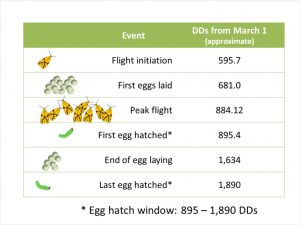
Sparganothis degree-day model benchmark
Based on our degree-day (DD) model for Sparganothis fruitworm, peak flight is expected at around 884 DD and first eggs hatched expected at 895 DD (see chart). As of June 21, Sparganothis has accumulated 951 DD (using April 15 as biofix). This indicates that we have passed peak flight and eggs have just started to hatch. I will keep you updated as the season progresses.
